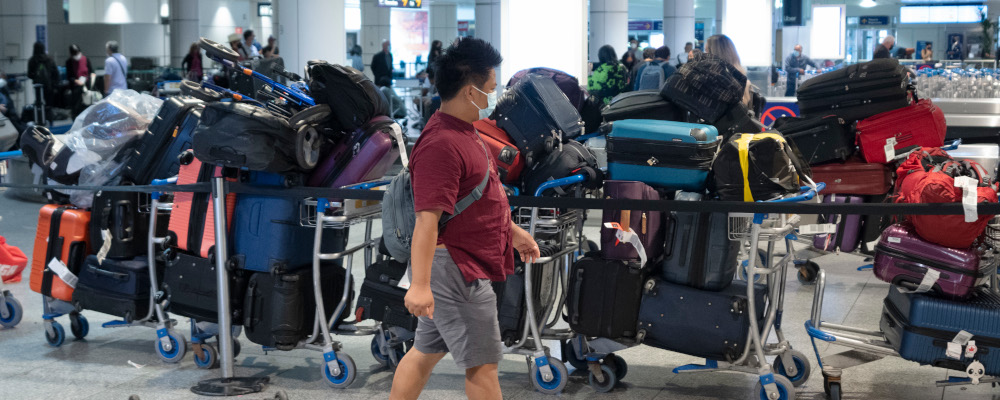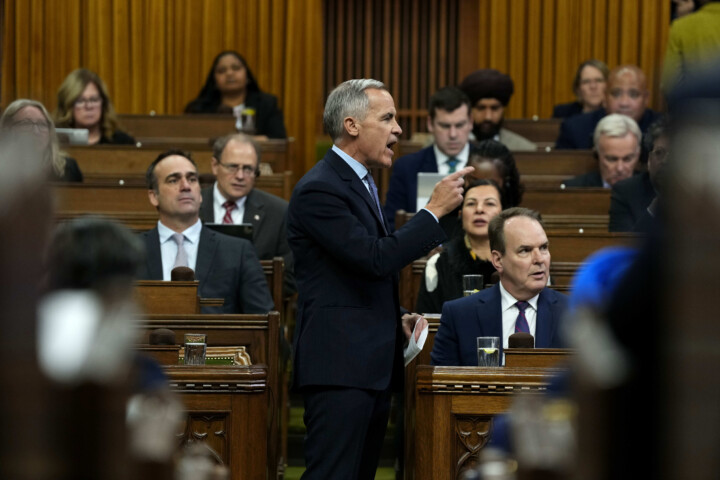There’s no sugarcoating it: air travel is terrible right now. It’s expensive, grueling, and uncertain. I’ve been lucky so far in my travels. The last time I landed at Pearson the flight attendant announced that we were going to be held on the plane for at least a half-hour, though mercifully she announced minutes later that we were free to go. In that moment, I was furious. I had to pay a premium for a flight that wound up being delayed at LaGuardia, so I was already frustrated. But I also know it could have been worse.
My partner sat in a security line at Pearson for two hours a few weeks ago. My parents had to sit on the tarmac for 45 minutes not long ago. I get it. It sucks. This is why, for the most part, I’m opting out of air travel this summer. Instead, I’m spending time driving to places like Detroit and Buffalo. I’ll leave London and Paris for the rest of you.
Here’s the thing, though: I’m not sure there’s really anyone to blame. Pausing and unpausing an economy is not something we’ve ever done before. If you put the economy in an induced coma, there’s going to be some grogginess. Even though airlines across the world were kept afloat by governments, you don’t just dust off a 737 and go. There was—and is—a tremendous amount of uncertainty surrounding global air travel. While we can argue that mistakes were made, I think we’re being too quick to rush to judgement. It’s possible that we made some unforced errors in Canada, though I’m skeptical that we’ve completely dropped the ball. After all, the rest of the world is facing many of the same challenges we are.
Air travel is a particularly difficult industry to ramp up. It’s a heavily regulated industry, and for good reason. There’s been some debate lately about whether pilots in the United States require too much training in order to fly. Is 1500 hours the right number? 750? I can’t tell you what the right answer is. But even since before COVID, some have complained that the 1500-hour rule was causing a pilot shortage. It’s also incredibly complex. There are a lot of logistics involved in flying 200-ton tubes around the world at 800 kilometers an hour. It takes a lot of skilled workers on the ground and some very patient people in the cabin and cockpit to make things work.
It also takes time to train and recruit flight attendants and ground crew. And there can be frictions. My partner and I travelled to Newfoundland last year, knowing it would be a place that almost certainly wasn’t going to shut down. I watched as one of the recently hired flight attendants fumbled with the intercom for several minutes before giving up and just starting the in-flight service unannounced. Upon arrival at the terminal, I watched as the ground crew struggled to work the bridge, to the amusement of the flight attendants. The flight attendants, in turn, had a bit of trouble opening the door. In short, there were a lot of tiny little frictions that added a few minutes here and a few minutes there.
Worse still, the industry isn’t going back to a normal environment—at least not yet. We’re still dealing with COVID, and plenty of passengers have been cranky about it. So a lot of people who enjoyed—or tolerated—the job before COVID have simply decided that they were born for better things than being yelled at by people who are mad about COVID restrictions.
The reopening of global air travel has been plagued with uncertainty. Last year we all hoped that COVID would be behind us. Instead, we got the Delta wave. Then for Christmas, we got Omicron. It wasn’t that long ago we were back to shutting down restaurants and sitting at home. No one had a clear idea of what this year would look like even a few months ago. So airlines around the world were caught flat-footed by the strong travel demand. As were airports and governments. Decisions made months ago are coming back to haunt us. But given that outcomes seemed to range from another lost travel season to everyone booking as much travel as they could afford, it’s no surprise that governments and industry missed the mark. This stuff is hard. When governments make mistakes they take heat. When businesses make mistakes they lose money. So it’s not surprising there was some excessive prudence.
The highly globalized nature of the airline industry makes it even more challenging. Problems in one country or one airport can cascade around the world. A thunderstorm in New York can mean missed connections at Heathrow or Pearson. Similarly, strikes in Europe can cause delays and cancellations across the board. Sometimes annoying things happen and there’s nothing we can do about it. Unless we want to wall off the country and spend all of our vacations in Banff and Whistler, there will always be factors beyond our control.
A lot of people were blaming vaccine mandates and random COVID testing for travel delays at the start of the summer. The mandate for domestic travel and random testing is gone, but the delays are still here. Others have blamed the government for continuing to use the ArriveCan app to log travelers. While I don’t have a firm opinion on whether there is a case for using the app now, I’m skeptical that it is a major source of delays.The federal government has claimed that ArriveCan actually saves passengers time going through customs.
Anecdotally, I can’t even remember showing the app upon my last return to Canada by air. An American friend who recently visited also can’t recall using the app. I’m sure that some people who are less technologically savvy might have problems, but it hasn’t been pervasive enough for me to notice.
I’m not here to apologize for all of the decisions that have been made along the way. I would love to be able to comfortably travel across the continent right now (or, heaven forbid, take that European trip we were supposed to take in 2020). But I think we need to appreciate that this was never going to be easy. It’s understandable that people are looking for someone to blame. But I’m just not sure who that is.
Insofar as there is a uniquely Canadian problem on top of the global airline challenges, it’s an issue with our major airports—Pearson most notably, but also Montreal. A recent report ranked Pearson the second-worst airport on earth for on-time departures, followed by Montreal at sixth.Canadian airlines, airports top global list of delays over the weekend https://www.ctvnews.ca/business/canadian-airlines-airports-top-global-list-of-delays-over-the-weekend-1.5973319 As a medium-sized country with only a few major metropolitans, it’s easy to forget that national problems can have hyper-local causes. Pearson and Montreal accounted for nearly 40 percent of Canadian passenger traffic in 2020.Air passenger traffic at Canadian airports, annual https://www150.statcan.gc.ca/t1/tbl1/en/tv.action?pid=2310025301 Throw in Vancouver and the three largest airports account for over 55 percent of passengers. Problems in Toronto, Montreal, or Vancouver cascade throughout the country. A flight crew stuck in Toronto means no flight to Calgary. It’s no surprise to me that the airline whose major hubs are Pearson, Montreal, and Vancouver had the worst on-time performance in the world.
When you cut through the noise about COVID policy and grievances with specific airlines, there’s an obvious problem: insufficient staff. This isn’t really a controversial point. The Minister of Transportation has acknowledged the staffing challenges at Pearson. Circling back to my point about staffing, it takes time to hire and train people. And those decisions had to be made months ago when it wasn’t clear how many people would be comfortable crammed into a plane with a hundred and seventy-three other peoples’ germs.
There’s also another problem: the red-hot labour market. Unemployment rates in North America are extremely low right now and finding people to work is hard. And if you have a lot of choices, having to drive out to Pearson to do airport screening for twenty-four bucks an hour might not be your top choice. This may well be an area where the Federal government and airport authorities dropped the ball.To be fair, some have claimed that it isn’t just that not enough people were hired but that many of those hired either didn’t pass their training or left for other jobs. See here, for instance. There is surely a dollar amount that would have brought more applications in the door. The consequences of over-hiring would have been trivial compared to under-hiring. Besides, if we were losing another travel season to COVID, we’d have much bigger things to worry about than the federal government overspending on airports.
While governments, airlines, and airport authorities could have made different choices that might have had better results, it’s important to recognize that there’s another party involved in travel: customers. We are all dying to travel, and those of us who can are doing so all at once. The world changed in March of 2020. So people’s habits rapidly changed. Travel was out, and home improvements were in. Unsurprisingly, that meant the cost of durable goods shot up and there were widespread shortages. Markets are good at accommodating changing consumer demand. But not right away. So we all bid up the price of lumber for home renos and spent months waiting for new home appliances. That isn’t much different from what’s happening right now but in reverse. People are prioritizing travel over household goods. This is understandable—they’re probably sick of sitting at home.
The world has been an unpredictable place since March of 2020. No one could have imagined that we’d lock people at home and put the economy into an induced coma. Within a few months, it seemed like normal travel patterns would never come back. Airport authorities, airlines, governments, us—none of us could have predicted such a rapid snapback in travel demand with any accuracy. The uncertainties weren’t just epidemiological. They were also psychological. Would people be permanently scarred, forever disgusted by the idea of rubbing elbows with strangers for three hours? Or would we rapidly develop miraculous vaccines that would allow an enthusiastic public to get back to normal life and then some?
In hindsight, we have answers to these questions. Most of us got vaccinated and want to get back to something like normal. After two years of pestilence and restrictions, it’s no surprise that people are looking for some human connection or some adventure. And right now, people are willing to put up with almost anything for those experiences. It’s not Air Canada’s fault if someone is willing to pay over $800 to fly economy to Los Angeles from Toronto any more than it’s Choice Hotels’ fault that people are willing to pay three hundred Canadian Dollars for a night at a Comfort Inn in Detroit some weekends. That’s just supply and demand at work.
So for now, we have delays, cancellations, and high prices. Hopefully, people will get the travel bug out of their systems soon and we will return to something like normal, with air travel a mundane affair once again. Until then, I’ll be (mostly) opting out. If anyone needs me, I’ll be driving through Upstate New York.
Recommended for You
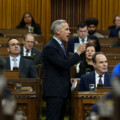
Carney gets a majority, but Canadians vote the Liberals out in a snap election: The Hub predicts 2026
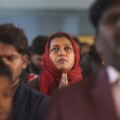
Why the return to religion matters
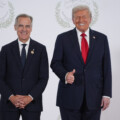
Supply management will be sacrificed to appease Trump, and the Netflix takeover is bad for Hollywood: The Hub predicts 2026

Canada will attempt to join the EU and Justin Trudeau becomes a Katy Perry lyric: The Hub predicts 2026

